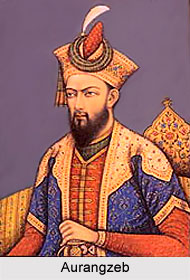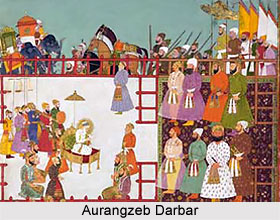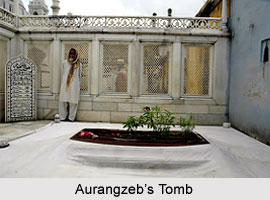 Aurangzeb was the third son of Shah Jahan and among the last Mughal Emperors to rule over India. He was born in 1618 at Dohad near Ujjain. Aurangzeb was a hardworking and thorough man who had proved himself as an able administrator in the years that he spent in the Deccan as well as other regions of the Empire. He learnt all the tactics of diplomacy due to his expertise as a skilled soldier and general and his accession to the throne was through a fierce battle with his own brothers, the contestants in the battle for authority. Under him the Mughal Dynasty reached its greatest height. He assumed the title of Alamgir (Conqueror of the World), Badshaah (emperor), and Ghazi (Holy Warrior) to propound the essence of the roles he would play. His experience as the governor of Gujarat, Multan and Sind helped him to strengthen his much coveted position. Being a deeply religious-minded man, he lived a most disciplined life. His food and dress were very simple and he never drank alcohol. He conducted his life strictly along Islamic laws.
Aurangzeb was the third son of Shah Jahan and among the last Mughal Emperors to rule over India. He was born in 1618 at Dohad near Ujjain. Aurangzeb was a hardworking and thorough man who had proved himself as an able administrator in the years that he spent in the Deccan as well as other regions of the Empire. He learnt all the tactics of diplomacy due to his expertise as a skilled soldier and general and his accession to the throne was through a fierce battle with his own brothers, the contestants in the battle for authority. Under him the Mughal Dynasty reached its greatest height. He assumed the title of Alamgir (Conqueror of the World), Badshaah (emperor), and Ghazi (Holy Warrior) to propound the essence of the roles he would play. His experience as the governor of Gujarat, Multan and Sind helped him to strengthen his much coveted position. Being a deeply religious-minded man, he lived a most disciplined life. His food and dress were very simple and he never drank alcohol. He conducted his life strictly along Islamic laws.
Administration of Aurangzeb
As a Mughal Emperor, Aurangzeb ruled over the largest area in India compared to the other monarchs. He proved himself as a capable ruler and ruled with an iron fist and keen intellect. Since his youth, Aurangzeb was deeply devoted to Islam and a staunch Sunni Muslim. It was in keeping with this that he lived a life of great piety even in the court and tried to rule the country as much as was possible along Islamic injunctions. Aurangzeb felt that he had become superior not only to administer the empire in a better way but also to protect and strengthen Islam particularly its Sunni faith. Aurangzeb believed that all Mughal rulers who ruled prior to him committed one blunder- they did not try to establish the supremacy of Islam in India. He therefore tried to reverse this trend during his reign because he believed that it was the foremost duty of a Muslim king. This duty of Aurangzeb limited his vision, narrowed his concept of kingship and made him intolerant towards the majority of his subjects. He introduced a number of reforms which would ensure a genuine Muslim rule in his dominion. He appointed censors of public morals in all important cities to enforce Islamic law, and he tried to put down such practices as drinking, gambling, and prostitution. Cultivation of Narcotics was banned throughout the Empire and even he banned Sati. He denounced all illegal exactions and did away with all those taxes which were not authorised by Muslim law. Even though these steps actually proved quite effective and popular with the people, he later went on to become increasingly Puritanistic. This included banning music at the court which led to a number of state musicians losing their jobs, festivities on the Emperor`s birthday and giving of gifts to the emperor were banned etc.
 His religious intolerance was reflected in a number of ways. He stopped celebrating the Hindu festivals like Holi, Diwali etc. at the court. He also framed certain laws to be observed by the Muslims as their religious duty. That is why even liberal Shias and Sufis were punished during the reign of Aurangzeb. Aurangzeb became quite intolerant towards the Hindus and ordered the provincial governors to demolish the schools and temples of the Hindus. In April 1679 A.D., Jizya was imposed on the Hindus. Pilgrimage tax on the Hindus was also revived and while the Muslim traders remained free from tax the Hindus were asked to pay a per cent of the value of their commodities as tax.
His religious intolerance was reflected in a number of ways. He stopped celebrating the Hindu festivals like Holi, Diwali etc. at the court. He also framed certain laws to be observed by the Muslims as their religious duty. That is why even liberal Shias and Sufis were punished during the reign of Aurangzeb. Aurangzeb became quite intolerant towards the Hindus and ordered the provincial governors to demolish the schools and temples of the Hindus. In April 1679 A.D., Jizya was imposed on the Hindus. Pilgrimage tax on the Hindus was also revived and while the Muslim traders remained free from tax the Hindus were asked to pay a per cent of the value of their commodities as tax.
In his administration, he was particularly attentive to matters concerning the maintenance of the imperial mosques. He built the beautiful Moti Masjid in the Red Fort, which is a jewel in white marble, and the magnificent Badshahi Mosque in Lahore, with its imposing domes towering over the red sandstone walls.
Military Campaigns of Aurangzeb
As a statesman his achievements have been quite immense. For one, the strong kingdoms of Bijapur and Golconda were captured in less than a year. It is a tribute to Aurangzeb`s control over the affairs of the empire that no major upheaval occurred in the north during his prolonged absence in the Deccan, but there are clear indications of many minor disturbances and a general slackening of administration.
Revolts during the Reign of Aurangzeb
 The first organised revolt of the Hindus against the policy of religious persecution of Aurangzeb was that of the Jat. The Jats under their leader Gokul revolted against the tyranny in 1669 A.D. In 1670 A.D., the temple of Keshav Rai was destroyed on the orders of Aurangzeb. It further inflamed the Hindus but they were however defeated in the battle of Tilpat. The Jats were punished severely but they remained undaunted. In 1686 A.D., they again raised the standard of revolt under their leader Raja Ram and gave serious trouble to the Mughals. This revolt of the Jats continued till the death of Aurangzeb and ultimately, the Jats succeeded in establishing their independent kingdom with its capital in Bharatpur. The revolt of the Satnamis was also an important occurrence during the reign of Aurangzeb. They fought bravely but were ultimately defeated by the forces of Aurangzeb. The Sikhs under the leadership of Guru Gobind Singh revolted against Aurangzeb. Though they did not succeed much against the mighty power of the emperor, but it made the Sikhs a powerful fighting community in Punjab because of which they played an important part in the future politics of Punjab. The Rajputs fought against Aurangzeb both on political and religious grounds. Aurangzeb doubted the loyalty of the Rajputs and desired to finish their independent existence and annex their states to the empire.
The first organised revolt of the Hindus against the policy of religious persecution of Aurangzeb was that of the Jat. The Jats under their leader Gokul revolted against the tyranny in 1669 A.D. In 1670 A.D., the temple of Keshav Rai was destroyed on the orders of Aurangzeb. It further inflamed the Hindus but they were however defeated in the battle of Tilpat. The Jats were punished severely but they remained undaunted. In 1686 A.D., they again raised the standard of revolt under their leader Raja Ram and gave serious trouble to the Mughals. This revolt of the Jats continued till the death of Aurangzeb and ultimately, the Jats succeeded in establishing their independent kingdom with its capital in Bharatpur. The revolt of the Satnamis was also an important occurrence during the reign of Aurangzeb. They fought bravely but were ultimately defeated by the forces of Aurangzeb. The Sikhs under the leadership of Guru Gobind Singh revolted against Aurangzeb. Though they did not succeed much against the mighty power of the emperor, but it made the Sikhs a powerful fighting community in Punjab because of which they played an important part in the future politics of Punjab. The Rajputs fought against Aurangzeb both on political and religious grounds. Aurangzeb doubted the loyalty of the Rajputs and desired to finish their independent existence and annex their states to the empire.
Combat with the Marathas
Aurangzeb`s aggressive Deccan Strategy was a blunder. His resolution was to subjugate the Shiah states of Bijapur and Golconda. The people of Bijapur gave the Mughals a tough situation with the support of the Marathas and the Sultan of Golconda. The rise of Shivaji disrupted the dreams of Aurangzeb. Mughal Governor, Shaista Khan could do no harm to the Marathas. But the Mughals under Jai Singh devastated Shivaji. However in 1665, Shivaji was forced to sign a peace treaty. All his lifetime he thwarted Mughal programmes of mashing Maratha influence. He died in 1680, asking his son Shambhuji to continue the war. Shambhuji gave shelter to Aurangzeb`s rebellious son, Prince Akbar. This act bothered Aurangzeb who came down to the Deccan in 1682, to deal with the situation. After repeated efforts, on 22nd September, 1682 he confiscated the land of the Bijapuris. Golconda too was besieged in 1687. But the Marathas ignited a national resistance against the Mughals by 1691.Their resurgence continued beyond 1700.
Aurangzeb was a well-read man and had command over the Persian, Turki and Hindi language. He even wrote beautiful Persian poem. A selection of his letters (Ruq`at-i-Alamgiri) is a testimony of simple and elegant prose composed by the Emperor. He understood music well but he gave up this amusement in accordance with Islamic injunctions. However, his religious fanaticism did no allow the arts to flourish in his courts, as he disbanded the musicians, abolished the office of the poet-laureate, discontinued the work of the court chronicler, and offered little encouragement to painters. In the cultural field, the chief contribution of Aurangzeb was the spread of Islamic learning and general diffusion of education. The Islamic academic curriculum, known as Dars-i-Nizamiya, was begun in his reign.
Aurangzeb resided in the Deccan till the last days of his life. Gradually with time, he could witness the errors he had committee in administration.. His long-term warfare had turned the royal treasury bankrupt. He wrote to his son Azam, while brooding over his shortcomings. He died in 1707. When he died, Aurangzeb left an empire faced with a number of menacing problems. The failure of his son`s successor led to the collapse of the empire in the mid-eighteenth century.






































